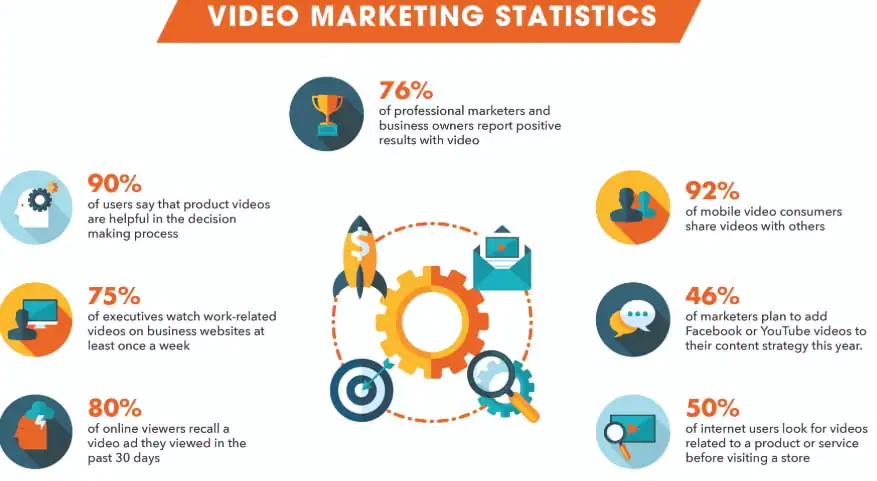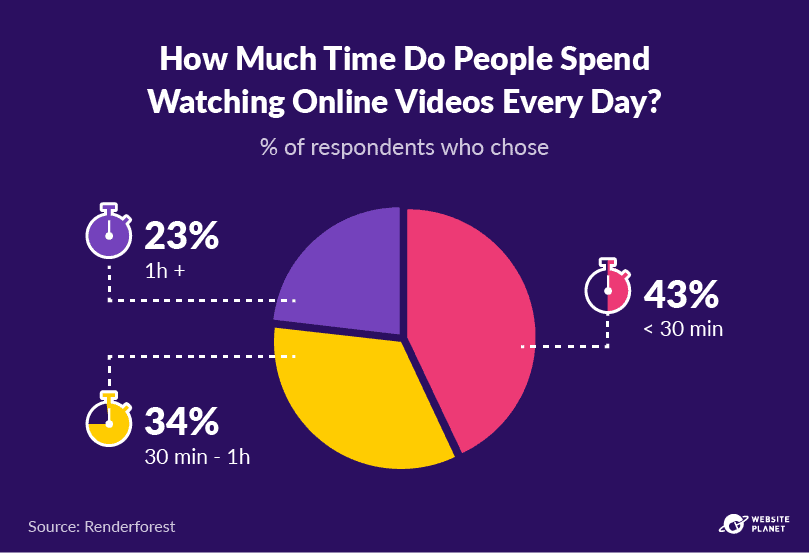Creative lead generation can help your B2B company fill the sales funnel with qualified prospects. Social media continues to be vital for marketing teams, and jumping on the upward trend of video content is a way to boost your outreach.
Utilizing video marketing is a great way to increase brand awareness and encourage content engagement. This tactic can push your outreach to additional target audiences and help increase your lead generation. Video marketing can also work when trying to retarget and engage potential prospects.
Keep reading, or use the following links to jump ahead:
- What is Video Marketing?
- Increasing Sales Conversions Through Videos
- How to Create a Successful Video Strategy
- Best Practices for Video Marketing
- Video Marketing & Social Media
What is Video Marketing?

While the strategy isn’t new, video marketing has become crucial for staying relevant in a competitive market. According to WyzOwl’s 2022 Video Marketing Statistic Report, 86% of businesses already use video in their marketing strategy.
This marketing tool is important to have across all channels. Videos are an easy way to educate prospects on your product, as well as create brand awareness.
In a Hubspot survey, it was found that video content was the second most popular way to increase social media engagement. By encouraging interaction from customers, this strategy can help boost shares and expand audience reach.
Even though video marketing has been around for a while, many businesses saw a rise in demand for this content during the pandemic. 64% of marketing teams feel the pandemic has affected their 2022 video marketing strategies. Coupling this with the rise of marketing on social media platforms like TikTok, utilizing these tools can make a big difference in engagement.
Increasing Sales Conversions Through Videos
Marketing teams work hard to reach audiences that can be converted successfully for the sales department. These tactics require a lot of planning and resources to make sure content is being delivered to the right prospects.
Video marketing is an accessible tool that helps engage customers before they’ve even spoken to a salesperson. If you’re just beginning your video strategy, a great place to start is finding ways to include this type of content on your website.
According to BizCommunity, conversion rates can be increased by 80% if you include video content on your landing pages. When leads are visiting your site for the first time, videos are able to introduce your product and brand quickly. This type of content encourages engagement as prospects are able to get a glimpse of what your company has to offer.
Additionally, adding videos to your site can help improve search engine optimization (SEO). By having this content on your pages, visitors are more likely to spend more time on your website, which helps boost your page in search engines.
Moving on from initial lead impressions, video marketing can play a role in boosting customer retention. This content has the ability to support salespeople as they walk clients through the sales journey. By having video tutorials and demonstrations, leads are able to interact with your product before making a purchase, which can increase customer confidence.
The options for video content are endless, and it is a great tool to build trust while showcasing an authentic brand to prospects. Utilizing how-tos, customer testimonials, and customer support videos are just a few ways your team can take its marketing strategy to the next level.
How to Create a Successful Video Strategy
Creating content that encourages audience engagement is a good starting place. With high-quality smartphone cameras and a multitude of editing apps to choose from, access to video creation is easier than ever.
However, starting without a plan can be an overwhelming undertaking for any marketing team. Take time to allocate resources and prepare your team for the content rollout. This type of foresight will help align the marketing and sales department to ensure the highest return on investment (ROI) is being achieved.
Once your teams are ready to go, begin by evaluating your company’s needs. Determine which pages and social platforms will benefit most from the content. Laying out the areas that will receive videos can help decide what the content will showcase.
Next, determine the target audience. For video marketing lead generation, have your team identify what platforms see the most traffic from prospects.
Bizcommunity found that videos help 90% of customers make buying decisions. By getting this content on pages that see the most interaction from leads, video influence can help push these prospects into the sales funnel.
Align the goals of the campaign across departments. Multiple videos can serve different purposes, but it is good to have a clear objective before creating any content. This data will also play a role in determining the video’s success late in the journey.
Decide on the video distribution platform. There are a few factors that will help narrow down the best place for your content. Consider your budget, including money for sponsored posts, and your current tools.
Shorter videos may find their home on TikTok or Instagram, whereas Youtube remains a leader for long-form content. Determining a platform before filming will help drive the subject matter. It is important to take into consideration the type of audience on each social media channel, as well as how engagement is measured.
Platforms like Instagram reels and TikTok rely on short, snappy videos that can quickly grab a viewer’s attention. These sites also work off of algorithms that rely on comments, likes, and shares. Longer videos may do better on Youtube or LinkedIn, especially if the goal of the content is to educate.
Begin scripting and filming content. If you are not sure where to start, look at similar businesses or competitors to see what type of videos they are sharing. This can help your team gather an understanding of where your industry fits into the digital sphere.
Once posted, begin measuring the content’s success. While each business may track unique metrics, there are a few basic ones that can help your team see what works and what needs improvement. Engagement is huge. Track comments, likes, and shares.
Time spent on your site is another great metric to consider. If you have longer videos, are your visitors watching the whole thing? Take a look at any generated leads or conversion boosts.
Are your visitors interacting with other areas of your site after watching the video? For example, keep an eye out for any upticks in form completion.
Lastly, continue to re-evaluate and produce video content. While you shouldn’t fix any content that seems to be working, don’t be afraid to add new posts. Variety in content can boost engagement and encourage frequent customer interaction.
Revisit any videos that don’t produce the results your team wants. This form of content is constantly evolving, and it is good to be prepared to embrace changes as needed.
Best Practices for Video Marketing
Once you have a strategy ready to go, implementing best practices can help boost the success of your marketing campaigns. Understanding the different types of video content can help your team see a positive ROI from this work.
Videos like product demonstrations, educational content, or expert interviews can help increase lead generation. While content like customer testimonials, live streams, or personalized messages from employees can create brand awareness.
Use video marketing to retarget old leads. This content can help encourage prospects to re-engage with the sales journey. Maybe the lead wasn’t sure your product was the right fit, but an educational tutorial or how-to guide can help show the ways their company can benefit from a purchase.
Video Marketing & Social Media

The rise of platforms like TikTok and Instagram has expedited the evolution of video content. Now, businesses are able to utilize these channels and interact with leads at a faster pace. In turn, social media has also helped shape marketing trends.
Viral trends dominate the ways content is viewed across platforms, and brands are not exempt from participation. While being TikTok famous isn’t the goal of video content for your business, it’s becoming more common for companies to participate in these trends.
In 2020, Statistica found that one-fourth of adults online have viewed videos posted on TikTok. Tapping into these markets and finding ways to engage with viewers is important for making the most out of your online presence.
Influencer marketing has also continued to rise in popularity. Videos like a how-to or product reviews from influencers help create brand awareness and build trust with customers. This type of sponsored content speaks to viewers without seeming too forced.
According to HubSpot, 64% of businesses found new customers because of a Facebook video. Social media helps successfully mix business with pleasure, as many adults spend time scrolling through Facebook and Instagram throughout the day. By posting video content on social media, your company can see a higher ROI on video marketing.
Get started with lead generation by trying out Leadboxer today!
